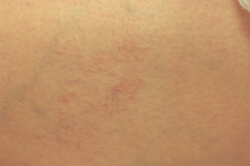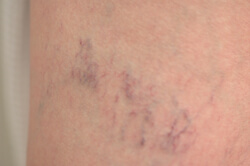It’s often said that an ounce of prevention is worth a pound of cure. This is especially true when it comes to our health. However, this idea becomes even more critical when you have a family history of a condition.
While spider veins aren’t especially dangerous, they can have a severe impact on your quality of life, and they often tend to run “in the family”. Spider veins (and varicose veins) can be painful—both physically and psychologically. They can affect your activities and your self-esteem. But there are things that you can do to prevent spider veins. Before we discuss specific strategies, it’s important to review why spider veins happen in the first place.


Spider Vein Treatment Before and After Picture
Prevent Spider Veins: Vital Tips & Insights
Our leg veins are designed to take blood back up to the heart by using a series of valves that channel the blood in a one-way direction. When some of these valves fail, blood moves backward in the wrong direction. This causes the small surface veins to dilate with blood and makes them visible as blue, purple or reddish vessels or mats of fine vessels. Factors such as weight, pregnancy, blood pressure and overall general health can contribute to developing faulty valves, but most of the time the tendency to have faulty valves comes down to hereditary factors.
Now, how can we prevent them? First, spider veins tend to be worse and occur more often if you have a job that requires you to sit or stand for extended periods of time. While you might think there’s no way of changing your working conditions, there are things that you can do while you’re sitting or standing to help keep the blood flow moving in the right direction. Ankle pumps are as simple as flexing the foot up towards the shin and then back down towards the floor. This heel-toe action stimulates the calf muscles, helping to keep the blood in the leg veins moving in and up.
If you stand on the job, do some tip-toe raises every so often to stimulate the calf muscles. Remember your movements affect the proper movement of blood in the venous system. The more sedentary or still you are, the more likely those leaky valves will leak!
Enhance Leg Health: Prevent Spider Veins
Next, consider wearing support hose. These are constrictive “socks” that can reinforce and enhance the work of the muscles in the lower legs. It’s important to note that these are so much more than just “tight” socks. They are specially designed with graded levels of support. They are considered medical devices by some insurance companies and will sometimes be covered by or paid in part by your insurance if prescribed by your practitioner. Never wear restrictive clothing in place of support hose. This can do more harm than good and trigger more types of problems. Also remember not to wear your support hose when sleeping unless you’re directed to do so by your practitioner.
Third, if you sleep with a pillow under your knees to help your lower back, consider turning it from horizontal to vertical. While sleeping, the edge of a firm pillow may place pressure on the larger vein in the back of the thigh and cause congestion in the lower leg veins. Turning the pillow the other way helps take the pressure off the middle part of the back of your thigh.
Next, ask your primary practitioner if there are any medications that you’re taking that may predispose you to developing spider veins. Some prescriptions like oral contraceptives can contribute to the formation of spider veins, so make sure to ask if this is a concern for you.
Last, but not least, exercise every day. This is so important to your overall health. Stimulating your muscles and heart with regular exercise will keep your body functioning at its very best. It also greatly improves the blood flow in the legs which helps dramatically lower your risk of developing varicose and spider veins.

